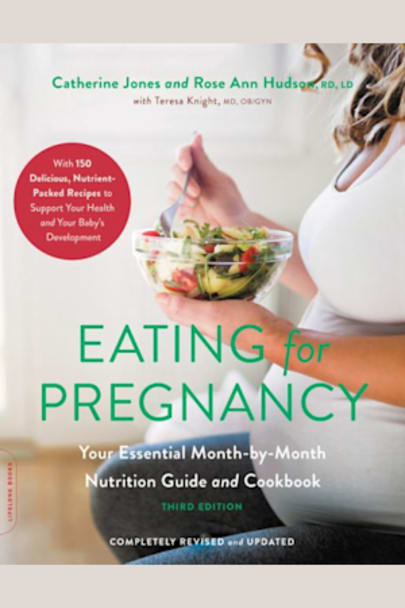The comprehensive pregnancy nutrition guide, completely revised to cover baby’s development and mom’s health month by month, and updated with the latest research and 25 new recipes Eating for Pregnancy is the ultimate no-nonsense nutrition guide and cookbook for moms-to-be. Every pregnant woman understands that what she eats and drinks affects the baby growing within her. Yet many of them don’t … her. Yet many of them don’t have the time or energy to ensure they’re always eating right. The guide walks readers through pregnancy month-by-month to cover developmental highlights, body changes, and nutritional needs of the mother and baby. Each chapter shares delicious, healthful recipes that put a special emphasis on the nutrients that mother and baby need that month, during preconception, the nine months of pregnancy, and the postpartum period. Each of the 150 recipes highlights the essential nutrients for mom and growing baby, and provides handy nutritional breakdowns and complete meal ideas.
- 25 brand-new recipes and updated classics, with more quick and easy dishes, more vegan and vegetarian recipes and variations, and more gluten-free options
- The most up-to-date information on supplements, nutrient sources, environmental concerns, and high-risk pregnancies
- Guidance for mothers with diabetes or gestational diabetes, including low-carb meal plans, recipe variations, and dining-out strategies
more



Eating for Pregnancy is a detailed nutritional book that offers guidance to women throughout their reproductive life. It is inclusive and diverse to consider most possible food requirements and restrictions in their recipes:- gluten-free, dairy-free, vegetarian, vegans, and diabetics.
The authors considered women who would:
1) want to optimize their bodies for conception by guiding them through the proper mindset and foods that help balance implantation and fertilization;
2) want to maximize their pregnancy journey by eating what is best for them and their growing babies and still have delicious options; and
3) want to manage their food menus after birth when they rely on their partner or family/friends to help them with food preparation.
The book has marked chapter topics, so readers are not assumed to read from start to finish but can jump between chapters based on their customized needs. The information provided are all evidence-based, with scientific documentation referred.
For those who are planning to conceive, this book helps mothers prepare through the science of nutrition and exercise. It gives a holistic approach in finding out that through a focused diet to get the body at its prime condition in the Preconception section.
For already pregnant mothers, each nutritional needs are broken-down per month with small discussions on the mother’s body, baby development, and appropriate recipes for that month. The wordings used were easy to understand. The menu suggestion and safe exercises are great bonuses at the end!
I wanted to point out that this book guides mothers to diabetes, obesity, and high blood pressure/preeclampsia. This book provides a complete section on gestational diabetes based on in-depth research-based information plus delicious recipes to support a woman’s needs.
I want to point out that Catherine, one of the co-authors, had gone through preeclampsia on both pregnancies, wherein one of them was a preemie, and the baby had to spend two months in the NICU with multiple surgeries. After that heart-wrenching experience, she made it her mission to help other pregnant women, especially those with complications.
The Fourth Trimester, a now important topic, is well-discussed. This is the 12-week period immediately after birth. Health care providers now give this term importance, wherein every mother and their newborn baby’s physical, emotional, and nutritional needs are taken into consideration.
Eating for Pregnancy talks about the mother’s and baby’s physical and emotional adjustment period as (a) the baby adjusts to being outside the womb, and (b) the mother adjusts to her new life as a mother; the mindset/approach and food demands. It is because, during this time, some of these needs may fall at the wayside as mothers try to adjust to the whole household’s “new normal.” If you think the pandemic is a big adjustment, wait and see when you have a new bundle of joy, whose only mode of communication is through sounds.
I appreciate the authors’ section on handling postpartum depression (PPD). Although this is not a self-help book, shared stories and signs help mothers identify possible baby blues and/or PPD symptoms. Recognizing the signs early on will help mothers get the proper support and treatment to address the issues. There are informative suggestions, tips, and FAQs about baby blues and PPD. Identifying is step one, then it is best to refer to a professional for proper diagnosis.
It is good to note that although the book looks at Western women’s body type and their geographical settings, Asian women can still use this book as a close guide with food choices and caloric intake. The weight gains are still the same, but the food and ingredient choices may be harder to find in Asian or even developing countries. Substitutes would still work, though the book has not provided this, so it is up to the mother’s discretion to find this.
In summary, I liked how the book guides women through their reproductive lives while suggesting exciting recipes that can please everyone in the family. I like how the authors include suggestions on healthy food options for people with diabetes that would still benefit everyone at home.
Note: The book is a guide/reference, but I would highly recommend having your doctor and/or a nutritionist help mothers customize better their physical, nutritional, and emotional needs.